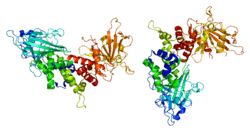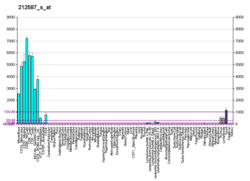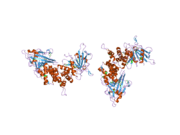PTPRC
Protein tyrosine phosphatase, receptor type, C also known as PTPRC is an enzyme that, in humans, is encoded by the PTPRC gene.[5] PTPRC is also known as CD45 antigen (CD stands for cluster of differentiation), which was originally called leukocyte common antigen (LCA).[6]
Function
The protein product of this gene, best known as CD45, is a member of the protein tyrosine phosphatase (PTP) family. PTPs are signaling molecules that regulate a variety of cellular processes including cell growth, differentiation, mitotic cycle, and oncogenic transformation. CD45 contains an extracellular domain, a single transmembrane segment, and two tandem intracytoplasmic catalytic domains, and thus belongs to the receptor type PTP family.
CD45 is a type I transmembrane protein that is present in various isoforms on all differentiated hematopoietic cells (except erythrocytes and plasma cells).[7] CD45 has been shown to be an essential regulator of T- and B-cell antigen receptor signaling. It functions through either direct interaction with components of the antigen receptor complexes via its extracellular domain (a form of co-stimulation), or by activating various Src family kinases required for the antigen receptor signaling via its cytoplasmic domain. CD45 also suppresses JAK kinases, and so functions as a negative regulator of cytokine receptor signaling.
Many alternatively spliced transcripts variants of this gene, which encode distinct isoforms, have been reported.[6] Antibodies against the different isoforms of CD45 are used in routine immunohistochemistry to differentiate between immune cell types, as well as to differentiate between histological sections from lymphomas and carcinomas.[8]
Isoforms
The CD45 protein family consists of multiple members that are all products of a single complex gene. This gene contains 34 exons, producing a massive protein with extracellular and cytoplasmic domains that are both unusually large. Exons 4, 5, and 6 (corresponding to protein regions A, B, and C) are alternatively spliced to generate up to eight different protein products featuring combinations of zero, one, two, or all three exons.[9]
CD45's large extracellular domain is highly glycosylated, and these eight isoforms allow wide variation in the structure of its side chains. The isoforms affect the protein's N-terminal region, which extends linearly out from the cell and bears the O-linked glycan chains.
CD45 isoforms show cell-type and differentiation-stage specific expression, a pattern which is quite well conserved in mammals.[10] These isoforms are often used as markers that identify and distinguish between different types of immune cells.
Naive T lymphocytes are typically positive for CD45RA, which includes only the A protein region. Activated and memory T lymphocytes express CD45RO, the shortest CD45 isoform, which lacks all three of the A, B, and C regions. This shortest isoform facilitates T cell activation.
CD45R (also known as CD45RABC) contains all three possible exons. It is the longest protein and migrates at 200 kDa when isolated from T cells. B cells also express CD45R with heavier glycosylation, bringing the molecular weight to 220 kDa, hence the name B220 (B cell isoform of 220 kDa). B220 expression is not restricted to B cells and can also be expressed on activated T cells, on a subset of dendritic cells, and on other antigen-presenting cells.
Interactions
PTPRC has been shown to interact with:
CD45 has been recently shown to interact with the HCMV UL11 protein. This interaction results in functional paralysis of T cells.[18] In addition, CD45 was shown to be the target of the species D adenovirus 19a E3/49K protein to inhibit the activation of NK and T cells.[19]
Clinical importance
CD45 is a pan-leukocyte protein with tyrosine phosphatase activity involved in the regulation of signal transduction in hematopoiesis. CD45 does not colocalize with lipid rafts on murine and human non-transformed hematopoietic cells, but CD45 positioning within lipid rafts is modified during their oncogenic transformation to acute myeloid leukemia. CD45 colocalizes with lipid rafts on AML cells, which contributes to elevated GM-CSF signal intensity involved in proliferation of leukemic cells.[20]
Use as a congenic marker
There are two identifiable alleles of CD45 in mice: CD45.1 (Ly5.1 historically) and CD45.2 (Ly5.2 historically).[21] These two types of CD45 are believed to be functionally identical. As such, they are routinely used in scientific research to allow identification of cells. For instance, leukocytes can be transferred from a CD45.1 donor mouse, into a CD45.2 host mouse, and can be subsequently identified due to their expression of CD45.1. This technique is also routinely used when generating chimeras. An alternative system is the use of CD90 (Thy1) alleles, which CD90.1/CD90.2 system is used in the same manner as the CD45.1/CD45.2 system.
References
- ENSG00000262418 GRCh38: Ensembl release 89: ENSG00000081237, ENSG00000262418 - Ensembl, May 2017
- GRCm38: Ensembl release 89: ENSMUSG00000026395 - Ensembl, May 2017
- "Human PubMed Reference:". National Center for Biotechnology Information, U.S. National Library of Medicine.
- "Mouse PubMed Reference:". National Center for Biotechnology Information, U.S. National Library of Medicine.
- Kaplan R, Morse B, Huebner K, Croce C, Howk R, Ravera M, et al. (September 1990). "Cloning of three human tyrosine phosphatases reveals a multigene family of receptor-linked protein-tyrosine-phosphatases expressed in brain". Proceedings of the National Academy of Sciences of the United States of America. 87 (18): 7000–4. Bibcode:1990PNAS...87.7000K. doi:10.1073/pnas.87.18.7000. PMC 54670. PMID 2169617.
- "Entrez Gene: PTPRC protein tyrosine phosphatase, receptor type, C".
- Holmes N (February 2006). "CD45: all is not yet crystal clear". Immunology. 117 (2): 145–55. doi:10.1111/j.1365-2567.2005.02265.x. PMC 1782222. PMID 16423050.
- Leong AS, Cooper K, Leong FJ (2003). Manual of Diagnostic Cytology (2nd ed.). Greenwich Medical Media, Ltd. pp. 121–124. ISBN 1-84110-100-1.
- "Mini-review: CD45 characterization and Isoforms". Bio-Rad Laboratories, Inc.
- Hermiston ML, Xu Z, Weiss A (2003). "CD45: a critical regulator of signaling thresholds in immune cells". Annual Review of Immunology. 21: 107–37. doi:10.1146/annurev.immunol.21.120601.140946. PMID 12414720.
- Arendt CW, Ostergaard HL (May 1997). "Identification of the CD45-associated 116-kDa and 80-kDa proteins as the alpha- and beta-subunits of alpha-glucosidase II". The Journal of Biological Chemistry. 272 (20): 13117–25. doi:10.1074/jbc.272.20.13117. PMID 9148925.
- Baldwin TA, Gogela-Spehar M, Ostergaard HL (October 2000). "Specific isoforms of the resident endoplasmic reticulum protein glucosidase II associate with the CD45 protein-tyrosine phosphatase via a lectin-like interaction". The Journal of Biological Chemistry. 275 (41): 32071–6. doi:10.1074/jbc.M003088200. PMID 10921916.
- Baldwin TA, Ostergaard HL (October 2001). "Developmentally regulated changes in glucosidase II association with, and carbohydrate content of, the protein tyrosine phosphatase CD45". Journal of Immunology. 167 (7): 3829–35. doi:10.4049/jimmunol.167.7.3829. PMID 11564800.
- Brown VK, Ogle EW, Burkhardt AL, Rowley RB, Bolen JB, Justement LB (June 1994). "Multiple components of the B cell antigen receptor complex associate with the protein tyrosine phosphatase, CD45". The Journal of Biological Chemistry. 269 (25): 17238–44. PMID 7516335.
- Koretzky GA, Kohmetscher M, Ross S (April 1993). "CD45-associated kinase activity requires lck but not T cell receptor expression in the Jurkat T cell line". The Journal of Biological Chemistry. 268 (12): 8958–64. PMID 8473339.
- Ng DH, Watts JD, Aebersold R, Johnson P (January 1996). "Demonstration of a direct interaction between p56lck and the cytoplasmic domain of CD45 in vitro". The Journal of Biological Chemistry. 271 (3): 1295–300. doi:10.1074/jbc.271.3.1295. PMID 8576115.
- Wu L, Fu J, Shen SH (April 2002). "SKAP55 coupled with CD45 positively regulates T-cell receptor-mediated gene transcription". Molecular and Cellular Biology. 22 (8): 2673–86. doi:10.1128/mcb.22.8.2673-2686.2002. PMC 133720. PMID 11909961.
- Gabaev I, Steinbrück L, Pokoyski C, Pich A, Stanton RJ, Schwinzer R, et al. (December 2011). "The human cytomegalovirus UL11 protein interacts with the receptor tyrosine phosphatase CD45, resulting in functional paralysis of T cells". PLoS Pathogens. 7 (12): e1002432. doi:10.1371/journal.ppat.1002432. PMC 3234252. PMID 22174689.
- Windheim M, Southcombe JH, Kremmer E, Chaplin L, Urlaub D, Falk CS, Claus M, Mihm J, Braithwaite M, Dennehy K, Renz H, Sester M, Watzl C, Burgert HG. A unique secreted adenovirus E3 protein binds to the leukocyte common antigen CD45 and modulates leukocyte functions. Proc Natl Acad Sci U S A. 2013 Dec 10;110(50):E4884-93.
- Saint-Paul L, Nguyen CH, Buffière A, Pais de Barros JP, Hammann A, Landras-Guetta C, et al. (October 2016). "CD45 phosphatase is crucial for human and murine acute myeloid leukemia maintenance through its localization in lipid rafts". Oncotarget. 7 (40): 64785–64797. doi:10.18632/oncotarget.11622. PMC 5323116. PMID 27579617.
- Mobraaten LE (1994). "JAX NOTES: Ly5 Gene Nomenclature, C57BL/6J and SJL/J - A History of Change". The Jackson Laboratory. Archived from the original on 2015-01-08. Retrieved 2015-01-08.
Bibliography
- Tchilian EZ, Beverley PC (2002). "CD45 in memory and disease". Archivum Immunologiae Et Therapiae Experimentalis. 50 (2): 85–93. PMID 12022705.
- Ishikawa H, Tsuyama N, Abroun S, Liu S, Li FJ, Otsuyama K, et al. (September 2003). "Interleukin-6, CD45 and the src-kinases in myeloma cell proliferation". Leukemia & Lymphoma. 44 (9): 1477–81. doi:10.3109/10428190309178767. PMID 14565647.
- Stanton T, Boxall S, Bennett A, Kaleebu P, Watera C, Whitworth J, et al. (May 2004). "CD45 variant alleles: possibly increased frequency of a novel exon 4 CD45 polymorphism in HIV seropositive Ugandans". Immunogenetics. 56 (2): 107–10. doi:10.1007/s00251-004-0668-z. PMID 15057492.
- Huntington ND, Tarlinton DM (July 2004). "CD45: direct and indirect government of immune regulation". Immunology Letters. 94 (3): 167–74. doi:10.1016/j.imlet.2004.05.011. PMID 15275963.
- Jameson R (2006). "CD45". Immunology course for undergraduates. Davidson College. Retrieved 2011-10-24.









